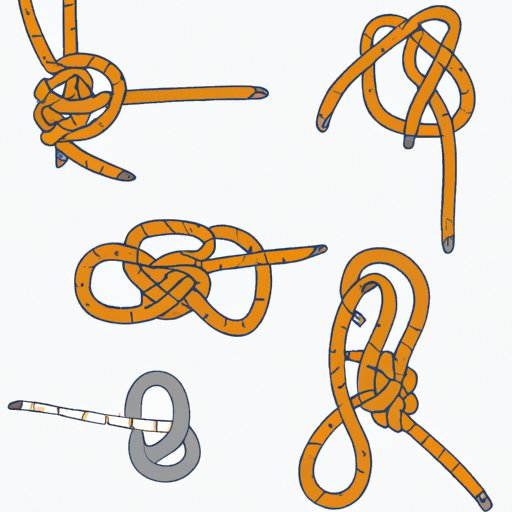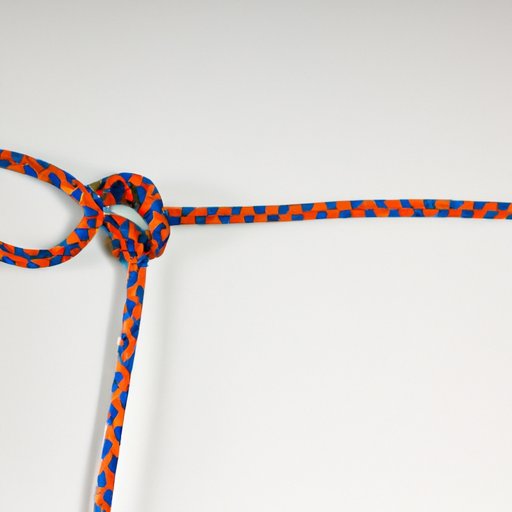How to Tie Knots: A Comprehensive Guide
Knots have been used by humans for thousands of years, serving a variety of practical purposes. Learning how to tie knots is an essential skill that can be useful in everyday life, from tying your shoelaces to securing heavy cargo. In this comprehensive guide, we will cover the basics of knot tying, different types of knots and their uses, knot tying in specific contexts, and tips and tricks for tying knots. Additionally, we will explore the history and cultural significance of knot tying, as well as tips for teaching knot tying effectively.

The Basics of Knot Tying
Knot tying requires a few essential materials, including a rope or cord, a surface to work on, and a pair of scissors for cutting the rope. Additionally, it’s crucial to take safety precautions when tying knots to prevent injuries, such as wearing gloves to protect your hands.
To tie basic knots, it’s essential to understand the mechanics of knot tying and follow a step-by-step guide. Two of the most common knots are the square knot and the half hitch knot. To tie a square knot, follow these steps:
- Take the end of the rope in your right hand and the other end in your left hand.
- Cross the right end over the left end and loop it through the middle.
- Take the left end and cross it over the right end, looping it through the middle as well.
- Tighten the knot by pulling both ends.
To tie a half hitch knot, follow these steps:
- Wrap the rope around a post or other object.
- Cross the end of the rope over the standing part.
- Tuck the end of the rope under the standing part and back over the top of the post.
- Pull the end of the rope tight.
To ensure that your knot is secure, it’s important to follow the steps precisely and pull the rope tight after each adjustment.
Different Types of Knots and Their Uses
There are many different types of knots, each suited to specific purposes. For example, the bowline knot is commonly used in boating to create a secure loop at the end of a rope. The figure-eight knot is often used in rock climbing to create a secure stopper knot. The clove hitch is often used in camping and other outdoor activities to attach a rope to a tree or post. The sheet bend is ideal for tying two different size ropes together.
To tie a bowline knot, follow these steps:
- Create a small loop in the middle of the rope.
- Bring the end of the rope up through the loop.
- Wrap the end of the rope around the standing part.
- Bring the end of the rope back down through the loop and pull it tight.
To tie a figure-eight knot, follow these steps:
- Create a small loop in the end of the rope.
- Bring the end of the rope over and around the standing part.
- Bring the end of the rope back up through the loop.
- Follow the rope back down through the loop and pull it tight.
To tie a clove hitch, follow these steps:
- Wrap the rope around an object.
- Cross the end of the rope over the standing part.
- Cross it over again.
- Tuck the end of the rope under the standing part and pull it tight.
To tie a sheet bend, follow these steps:
- Create a bight in the bigger rope.
- Thread the smaller rope through the bight.
- Wrap the smaller rope around the bight.
- Thread the smaller rope back through the bight and pull tight.
Knowing which knot to use will depend on the context and purpose of the knot.
Knot Tying in Specific Contexts
In addition to everyday uses for knot tying, there are also specific contexts where knot tying is important, such as tying a tie knot, tying fishing knots, and tying scouting knots for camping.
To tie a tie knot, follow these steps:
- Start with the wide end of the tie on your right side, and the thin end on your left side.
- Cross the wide end over the thin end.
- Bring the wide end up and over the loop around your neck.
- Bring the wide end down through the loop between the tie and your neck.
- Cross the wide end in front of the thin end.
- Bring the wide end up and over the loop.
- Bring the wide end down through the loop again.
- Adjust the knot and make sure it sits correctly.
To tie fishing knots, it’s essential to understand the characteristics of the fishing line and to choose the right knot for the line’s thickness and material. Examples of common fishing knots include the improved clinch knot, the Palomar knot, and the blood knot.
To tie scouting knots for camping, it’s important to learn knots that serve practical purposes, such as the square knot for tying poles together, the bowline knot for tying down tent corners, and the taut-line hitch for adjusting tent guy lines.
Tips and Tricks for Tying Knots
The key to tying secure knots is to follow steps precisely and make sure the knot is tight. If you’re struggling to make the knot secure, try adding a half hitch or another extra twist.
If you need to untie a knot, start from the end of the knot and work your way out, using a pin or a small tool to loosen any tight areas. Additionally, practice and patience are crucial for mastering the art of knot tying. Keep practicing, and you’ll become more comfortable and confident with tying different knots.
The History and Cultural Significance of Knot Tying
Knot tying has a rich history and cultural significance, with origins dating back to ancient times. Different kinds of knots were used for various purposes in different societies, such as tying boats together, securing cargo, and even communicating secret messages. Knots were also used as decorations or symbols of rank or membership, as evidenced by the intricate knot designs in Celtic art.
Teaching Knot Tying
Knot tying can be a fun and interactive activity for kids and beginners. Simple activities, such as making friendship bracelets or creating a rope obstacle course, can help kids learn basic knot-tying skills. To teach knot tying effectively, it’s essential to have a patient and encouraging approach and to break down complicated knots into easy-to-understand steps.
Conclusion
In conclusion, learning how to tie knots is a valuable life skill that can be useful in various situations and contexts. With this comprehensive guide, you should now have a solid understanding of the basics of knot tying, how to tie different types of knots and their uses, knot tying in specific contexts, and tips and tricks for tying knots. Additionally, we explored the rich history and cultural significance of knot tying and tips for teaching knot tying effectively. So go ahead, practice your knot-tying skills, and you’ll be amazed at how useful this skill can be in your everyday life.
